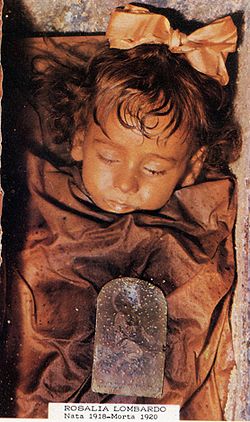Rosalia Lombardo: Difference between revisions
No edit summary |
MachineFist (talk | contribs) minor grammar fixes |
||
| Line 1: | Line 1: | ||
[[Image:Palermo Rosalia Lombardo.jpg|250 px|thumb|right|Rosalia Lombardo]] |
[[Image:Palermo Rosalia Lombardo.jpg|250 px|thumb|right|Rosalia Lombardo]] |
||
'''Rosalia Lombardo''' was an [[Italy|Italian]] child born in 1918 in [[Palermo]], [[Sicily]]. She died on December 6 1920 |
'''Rosalia Lombardo''' was an [[Italy|Italian]] child born in 1918 in [[Palermo]], [[Sicily]]. She died of [[pneumonia]] on December 6, 1920. Rosalia's father was sorely grieved upon her death, so he approached Dr. Alfredo Salafia, a noted embalmer, to preserve her. <ref>National Geographic magazine, Feb 2009, p.124</ref>She was one of the last corpses to be admitted to the [[Capuchin catacombs of Palermo]] in [[Sicily]]. |
||
==Embalming== |
==Embalming== |
||
Revision as of 00:24, 5 January 2010

Rosalia Lombardo was an Italian child born in 1918 in Palermo, Sicily. She died of pneumonia on December 6, 1920. Rosalia's father was sorely grieved upon her death, so he approached Dr. Alfredo Salafia, a noted embalmer, to preserve her. [1]She was one of the last corpses to be admitted to the Capuchin catacombs of Palermo in Sicily.
Embalming
Thanks to Dr. Salafia's embalming techniques, the body has been well-preserved. X-rays of the body show that the organs are remarkably intact. [2] The child appears as if she were only sleeping, hence receiving the name "Sleeping Beauty", though due to the discoloration that has become more pronounced in the years following her preservation, it is quite obvious she is deceased. Rosalia Lombardo's body is kept in a small chapel at the end of the catacomb's tour and is encased in a glass covered coffin, placed on a marble pedestal.
Technique
Recently the mummification techniques used by Dr. Salafia were rediscovered in a handwritten memoir of Salafia's. Dr. Salafia replaced the girl's blood with a liquid made of formalin to kill bacteria, alcohol to dry the body, glycerin to keep her from overdrying, salicylic acid to kill fungi, and the most important ingredient, zinc salts to give the body rigidity.[3][4][5] The formula is 1 part glycerin, 1 part formalin saturated with both zinc sulfate and chloride, and 1 part of an alcohol solution saturated with salicylic acid.
References
- ^ National Geographic magazine, Feb 2009, p.124
- ^ National Geographic magazine, Feb 2009, p.150
- ^ http://news.nationalgeographic.com/news/2009/01/090126-sicily-mummy.html
- ^ http://www.spiegel.de/wissenschaft/mensch/0,1518,623616,00.html
- ^ Piombino-Mascali D, Aufderheide AC, Johnson-Williams M, Zink AR (2009). "The Salafia method rediscovered". Virchows Arch. 454 (3): 355–7. doi:10.1007/s00428-009-0738-6. PMID 19205728.
{{cite journal}}: Unknown parameter|month=ignored (help)CS1 maint: multiple names: authors list (link)
